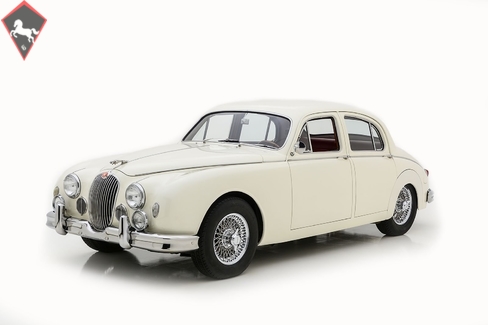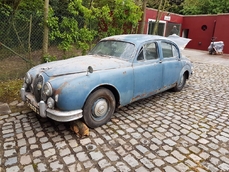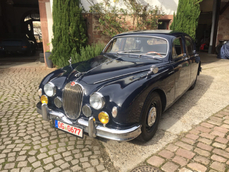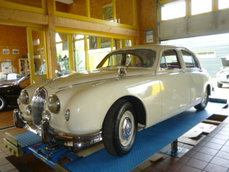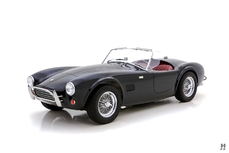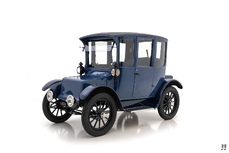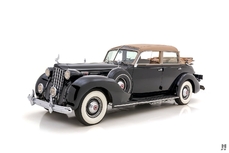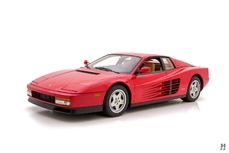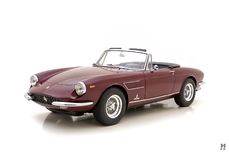Jaguar Mk1 I 3.4 Saloon 1957
General description :
In the mid-1950s, Jaguar was riding high on the wave created by their revolutionary, highly advanced "XK" twin-cam inline-six. The engine is best known for its tenure in the sumptuous XK120, 140, and 150 sports cars, and it powered the world-beating C-Type and D-Type sports racers to six victories in the 24h of LeMans. Even the massive XK-powered Mk VII and Mk IX luxury cars enjoyed considerable success in British Saloon Car racing in the hands of Stirling Moss, Roy Salvadori, and others. Despite their performance ability, these big saloon cars were stylish and luxuriously appointed. Buoyed by their success, Jaguar saw an opportunity to appeal to an even broader market with a smaller, compact luxury saloon that shared the same successful bloodline with their sports cars and luxury sedans. They debuted an all-new, technologically advanced midsize sedan in 1955. The car featured Jaguar's first-ever road-going monocoque chassis with power coming from either 2.4 or 3.4-liter versions of the glorious XK twin-cam inline-six and manual or automatic transmissions. Inspiration for the curvaceous body style came from the XK sports cars, and despite the smaller size, it featured luxurious traditional leather, wool, and wood trim. Almost immediately, racers saw the car's tremendous potential and soon began racking up even more hardware for Jaguar's already stuffed trophy cabinet.
With the introduction of the revised Mk II version in 1959, the original 3.4 became retroactively known as the "Mk I." Compact and sporty, the Mk I is widely considered the father of the modern sports saloon, and enthusiasts cherish them for their performance, luxurious appointments, and pure, undiluted style.
This 1957 Mk I 3.4 is a superb example of Jaguar's seminal sports saloon. Presented in the classic combination of Old English White over a gorgeous red leather interior, this car is the recipient of a comprehensive, nut and bolt restoration by noted restoration specialists Vantage Motors of Connecticut. Extensive documentation kept by the previous owner shows he purchased the car in 1999, then promptly handed it over to Vantage for restoration. From the photos, we see it was a complete and original car, but quite tired, finished ex-factory in regency red over a red interior, and fitted with steel disc wheels and automatic gearbox.
The body was soon stripped down to bare metal, and the corrosion repaired, followed by the application of German "Schutz" chip guard to the underbody, wheel wells, and inner boot. With the body prepped, a layer of Old English White was applied to the whole shell. The body fit is exemplary, with doors that shut with a satisfying click, straight panels, and tight, even gaps all around. All chrome parts were removed, stripped, and repaired as necessary before being plated to concours standards. Details include chrome knock-off wire wheels fitted with Dunlop radial tires and a set of period-correct Lucas Ranger/Fog Ranger auxiliary lamps. While it has been some years since the car first rolled out of the Vantage Motors workshop, the Jaguar remains in superb condition from top to bottom with gorgeous paintwork and finishing.
Following the body restoration, the interior was handed over to the award-winning experts at Coachtrim, LLC of Stamford, Connecticut. Using the same materials as the factory, including Connolly hides, Wilton wool carpets, and West of England broadcloth, Coachtrim fabricated the soft trim from scratch. Improvements include a subtly reshaped driver's seat for better support and perforated kick panels to conceal speakers for the updated audio system. A hallmark of the Mk I interior is the extensive use of burl wood on the dash and window surrounds. The trim and fascia were restored to a high standard, and housing refurbished instruments and switchgear. In the time since the restoration, the soft trim remains in superb condition and has acquired a charming character in the leather seats from gentle use. Updates include seatbelts, a sporty wood-rimmed Momo steering wheel, and a period-look, modern AM/FM stereo with boot-mounted CD changer, the latter of which is protected by a custom cover to match the factory style boot upholstery.
Photos and receipts show the 3.4-liter inline-six received a complete tear-down and rebuild, with noteworthy components including new pistons, a reground crank, new bearings, new valves, and valve guides. The engine consists of a matching-numbers block with a replacement cylinder head, and a preferred four-speed manual with Laycock overdrive takes the place of the original Borg-Warner automatic, utilizing factory components for seamless integration. The fully-restored chassis features desirable four-wheel disc brakes, stainless steel exhaust, and the addition of Koni red dampers to improve cornering control. The mechanical components show some light signs of use, such as "baking off" of the porcelain exhaust manifolds, and some general road wear on the undercarriage. However, considering the time elapsed since the restoration, it is in superb condition all around.
The result of all of the effort and expense of the restoration came with an award for Most Outstanding Jaguar at the 2003 Greenwich Concours d'Elegance. Since that time, it has received attentive care and remains in truly outstanding condition. We rarely see Mk I saloons so comprehensively restored as this incredible example. With its desirable upgrades, this Jaguar would make a worthy candidate for entry into any number of premier driving events around the world.
Offers welcome and trades considered
https://hymanltd.com/vehicles/6545
1957 Jaguar Mk1 I 3.4 Saloon is listed sold on ClassicDigest in St. Louis by Mark Hyman for $67500.
Car Facts
Car type : Car Make : Jaguar Model : Mk1 Model Version : I 3.4 Saloon Engine size : 0.0 Model Year : 1957 Sub type : Sedan Location : Missouri
Sold
Seller Information
Sold
People who viewed this Jaguar Mk1 also viewed similar Jaguar listed at ClassicDigest
Other cars listed for sale by this dealer
About Jaguar
Ah, the story of Jaguar, from its early days as the SS Cars Ltd. to its pinnacle with the D-type, and the street-going evolution in the form of the iconic E-type. There's something quintessentially British about this tale, and I'll narrate it as a British journalist might.In the Beginnings:
Our journey into the world of Jaguar begins in the 1930s, when a company known as SS Cars Ltd. emerged. Despite the unfortunate coincidence of their initials with the rising political tensions in Europe, they started producing stylish and performance-oriented cars. The SS 100, introduced in 1936, was a symbol of elegance and speed, setting the stage for what would become Jaguar.
The Birth of Jaguar:
As the shadows of World War II loomed, SS Cars Ltd. wisely decided to disassociate themselves from the SS initials. Thus, in 1945, they officially became Jaguar Cars Ltd., a name that would soon be synonymous with British luxury and performance.
The XK Series:
Jaguar's post-war era brought us the XK 120, a true sensation in 1948. With its sleek design and a powerful 3.4-liter inline-six engine, it became the world's fastest production car. The XK 120 was the blueprint for what lay ahead – Jaguars that blended style with speed in a uniquely British fashion.
The D-type Dominance:
Then came the D-type, a true racing legend. Introduced in 1954, it won Le Mans three times in the 1950s, showcasing Jaguar's engineering prowess. With its innovative monocoque construction and the iconic fin at the back, the D-type was the apex of Jaguar's motorsport success.
The E-type Emergence:
But the true turning point arrived in 1961 with the introduction of the E-type, often described by Enzo Ferrari as "the most beautiful car ever made." Its long bonnet, curvaceous body, and a 3.8-liter engine delivering exhilarating performance made it an instant classic. The E-type was not just a car; it was a work of art on wheels, and it could hit 150 mph on the road.
Street and Racing Success:
The E-type's beauty was matched by its capability on the track. The lightweight E-types were particularly successful in various racing events, cementing Jaguar's reputation as a force to be reckoned with in motorsport.
The Age of Refinement:
As we delve deeper into the Jaguar story, we find that the 1950s and 1960s were an age of refinement and expansion. Alongside the magnificent D-type and the E-type's iconic emergence, Jaguar introduced models that further solidified its reputation for luxury and performance.
The MK2:
In the late 1950s, Jaguar unveiled the MK2, a sports sedan that combined elegance with power. This sleek four-door saloon was a favorite of bank robbers and law enforcement alike, thanks to its exceptional speed and handling. The MK2 was a symbol of Jaguar's ability to blend sophistication with performance and had a successful racing career as well.
The XJ6:
Fast forward to 1968, and Jaguar launched a car that would define luxury saloons for decades to come – the XJ6. It was a masterpiece of engineering and design, featuring a smooth inline-six engine, independent rear suspension, and a spacious, beautifully appointed interior. The XJ6 was a symbol of British elegance and provided a ride so smooth that it seemed to glide over the road. It became the flagship model for Jaguar and set the standard for luxury saloons, showcasing a level of refinement that left competitors in awe.
The Blend of Classic and Modern:
While the MK2 and XJ6 represented the evolution of Jaguar's saloon cars, they maintained the brand's commitment to performance and luxury. These cars didn't just belong on the racetrack; they were equally at home cruising down the grand boulevards or gliding through the English countryside.
The Challenges of Change:
However, as the 1970s arrived, Jaguar, like many British automakers, faced financial challenges and changes in ownership. The British Leyland era brought both opportunities and struggles, as the brand navigated through various mergers and transitions.
Nevertheless, the legacy of the MK2 and XJ6, along with the D-type and E-type, continues to define Jaguar as a manufacturer that combines timeless elegance with a spirit of performance. These classic models, whether driven on winding roads or parked as collectors' treasures, serve as a testament to Jaguar's enduring presence in the world of automotive excellence.
The Jaguar story, from its early days as SS Cars Ltd. to the creation of automotive icons like the E-type, MK2, and XJ6, is a journey that reflects the very essence of British motoring – a blend of luxury, power, and style that continues to captivate enthusiasts and connoisseurs alike.
